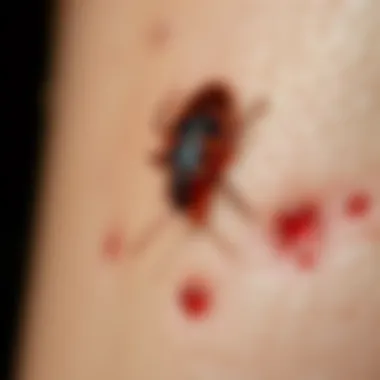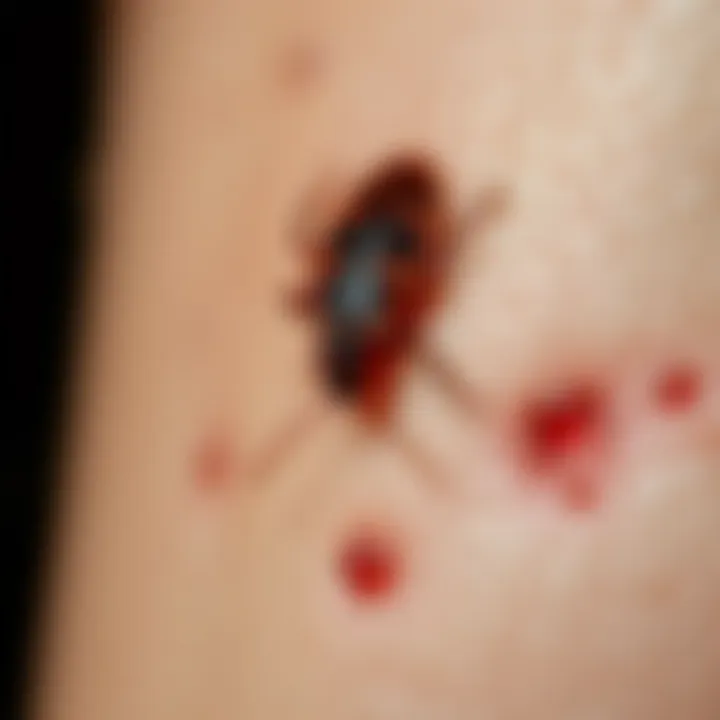Bed Bug Experiences: Insights and Real-Life Stories


Intro
Bed bugs have become a common topic of discussion in recent years, often provoking discomfort and anxiety among many. These small, elusive pests infiltrate homes, causing sleepless nights and leaving a trail of distress in their wake. While many hear tales of bed bug woes, the reality of dealing with an infestation is layered with complexities that go beyond just annoyance. Understanding the nuances of bed bug experiences not only sheds light on effective identification and treatment but also addresses the often-overlooked psychological effects on those affected.
This article aims to guide you through the maze of information surrounding bed bugs, from understanding how to spot them to strategies that may help keep your home safe. We will dive into stories of personal encounters with these pests, hear from experts about their findings, and unveil myths that may cloud people's judgment. By equipping readers with knowledge and practical advice, we hope to foster a deeper understanding of this pervasive issue, making it easier to tackle bed bug infestations head-on.
As we unravel these tales, let’s take a closer look at an essential starting point: Pest Identification.
Pest Identification
Knowing how to identify bed bugs is crucial in preventing infestations. Bed bugs, scientifically known as Cimex lectularius, are small, flat, and reddish-brown insects. They typically grow to about a quarter of an inch in length and can easily hide in crevices. Recognizing them is the first step in the battle against these unwelcome guests.
Detailed Descriptions of Common Pests
- Bed Bugs
These critters prefer the warmth of our beds and are notorious for feeding on human blood. They are not known to carry diseases but can cause allergic reactions and lead to psychological stress due to sleep deprivation. - Fleas
Often confused with bed bugs, fleas are slightly smaller, jumping insects that typically infest pets before spreading to other areas of the home. They too can give bites that itch, but their life cycle and habitats differ. - Dust Mites
Less visible than bed bugs, dust mites thrive in bedding and carpets. They do not bite. Instead, they cause allergies, hence often targeted in extermination efforts as a precaution.
Signs and Symptoms of Infestations
Detecting a bed bug presence early can save a lot of heartache. Here are some key indicators:
- Bites on Skin: Red, itchy welts are the classic signs, often in clusters.
- Blood Stains: Tiny blood stains on sheets or pillowcases can indicate feeding.
- Fecal Spots: Small, dark spots on bedding or furniture suggest bed bugs have been there.
- Shed Skins: As bed bugs grow, they shed their outer exoskeleton, leaving behind remnants.
"Early detection is key to managing bed bug infestations effectively; look closely, and act fast."
By tuning into these signs, homeowners can take swift action if needed, cutting off the bed bugs at the source before they take over.
In our next section, we’ll discuss Prevention Strategies that can keep these pests from making an unwelcome appearance in your home.
Foreword to Bed Bugs
Bed bugs have made a striking comeback in recent years, nudging their way into our homes and, consequently, into our psyche. This section sets the stage for understanding not just the biological aspects of these pests, but the broader narrative that envelops their presence in our daily lives. The importance of grasping the nuances of bed bugs extends beyond mere identification; it influences how we react to sightings, manage infestations, and, remarkably, how we engage in conversations regarding these uninvited guests.
Understanding bed bugs encompasses a variety of dimensions, from historical perspectives to their current prevalence in society. Whether you’re a housewife juggling chores or a homeowner trying to maintain a peaceful domicile, the knowledge of how bed bugs operate, their lifecycle, and how they proliferate can prove invaluable. Ignorance may lead to escalating issues, but informed actions can make a world of difference.
Historical Context
Bed bugs, scientifically known as Cimex lectularius, have been starring in our homes for thousands of years. They’ve nested in the creases of our mattresses and the shadows of our furniture long before many of us set foot in our current residences. Records suggest they were prevalent in ancient civilizations; even Aristotle referenced these pests in his writings. However, as urban areas grew and advancements in pest control methods emerged, these insects seemed to fade from our collective memory.
Fast forward to the late 20th century, and you’d be hard-pressed to find any trace of bed bugs in the narrative of household nuisances—until their unexpected resurgence. The rise of international travel, coupled with reduced public awareness, has opened the floodgates for these pests. Today, anecdotal evidence suggests they are thriving, not just in low-income settings but across affluent neighborhoods as well. This shift elevates the conversations surrounding them from mere nuisance to a pressing public health concern.
Current Prevalence
In recent years, bed bug infestations have reared their ugly heads in homes, hotels, and even hospitals. According to the National Pest Management Association, nearly 97% of pest control professionals have treated bed bug infestations in the past year alone. It's alarming to note how widespread the issue is, and it's not just an urban problem; even rural areas are feeling the pinch.
The prevalence of these pests raises critical questions about hygiene and awareness in our society. Many people still hold onto misconceptions about how bed bugs operate, believing that cleanliness can ward off such infestations. Unfortunately, these little critters care little for tidiness; they seek only a willing host. Homes in pristine condition have been infiltrated, proving that anyone can fall victim without proper preventative measures.
- Key factors contributing to their prevalence today include:
- Increased international travel
- Resurgence of second-hand furniture sales
- Changes in pest control practices
With each new report of bed bugs, emotional narratives emerge. People talk about sleepless nights and the dread of discovering those telltale bites. As daunting as the presence of bed bugs may be, it signals a pathological issue worth tackling head-on—with understanding and informed strategies.
Personal Encounters with Bed Bugs
Bed bug encounters represent a significant chapter in the narratives of many individuals, drawn from personal experiences that reveal the very heart of this troubling issue. Discussions surrounding bed bug confrontations often illuminate the sheer frustration and anxiety that such infestations can bring. These accounts provide a multifaceted view, allowing us to gauge the psychological toll as well as practical implications faced by those plagued by these resilient pests. Moreover, hearing firsthand stories arms readers with a better understanding of how to navigate similar situations, making them more prepared should they find themselves facing the same ordeal.
The Initial Discovery
For many, the first encounter with bed bugs comes as a surprise, often during the early morning when one might feel an itchy sensation upon waking. This was exactly what happened to Linda, a mother from Michigan. Just as she was sipping her coffee and scouting the day ahead, she noticed red welts emerging on her arms and legs. Initially brushing it off as allergies or a reaction to a new laundry detergent, she soon learned these were bites, indicating a deeper problem.
During her investigation, Linda found tiny brown specks on her mattress seams, those dreaded droppings left behind by bed bugs. That fateful morning propelled her into a series of alarming discoveries. The realization of having these unwelcome visitors rattled her to her core, prompting her to research and gather information.
One crucial takeaway from these initial findings is the importance of vigilance. Knowing the physical characteristics of bed bugs, including their size, shape, and coloring, helps in identifying them sooner. Visual aids or guides, available on educational platforms like Wikipedia, can provide useful information for recognizing these pests early on.
Experiencing Infestations
After the initial discovery comes the reality of living with an infestation. Linda’s story highlights the chaos that ensued when she chose to share her concerns with family members. To her dismay, misinformation spread quickly, resulting in her being labeled "that neighbor".
As she sought professional help and began intensive treatments, she learned that bed bugs can hide in the most unexpected nooks, from baseboards to behind wall art. The process of fumigation transformed her home into a battlefield against these pests. Recovery seemed daunting, not just in a physical sense but also mentally.


The constant anxiety of wondering whether these bugs were still lurking haunted many, shaping their daily lives. In a world focused on comfort and safety, the presence of bed bugs turns the home into a source of distress. Understanding this broader experience is vital. Homeowners should know they are not alone and countless families share similar unsettling stories, enhancing community support and awareness.
Recovery from Infestation
As distressing as it is to deal with the infestation, recovery is possible. The experiences shared by individuals like Linda reveal that while regaining a sense of normalcy can be arduous, it’s achievable. Linda documented her journey of tackling this pest resurgence step-by-step. After professional exterminators treated her home, her routine changed dramatically; she meticulously laundered linens and vacuumed daily, re-establishing her space as a haven.
She also discovered that recovery isn't solely about eliminating the bugs. It extends to rebuilding one’s peace of mind. Sharing her experience with a support group offered reassurance, reminding her she wasn't alone in her struggle. This reflective journey served to both empower her and deepen her understanding of the situation. This emotional aspect often gets overshadowed amidst the practical side of treatment plans, but it's equally essential to acknowledge.
"The battle against bed bugs taught me not just about pest control, but about resilience in the face of adversity," Linda remarked.
For further reading on recovery tactics and emotional support systems, resources like Reddit's bed bug community and various support forums offer fruitful insights.
Psychological Impact of Bed Bug Infestations
The significance of exploring the psychological repercussions of bed bug infestations cannot be overstated. Beyond the physical discomfort and inconvenience they cause, these pests can trigger profound emotional distress in individuals. Understanding how these experiences shape one's mental landscape is essential for both awareness and effective intervention. The tall tales spun around bed bugs aren't just mere anecdotes; they reveal the fragility of our peace at home and highlight the deep-seated fear these minuscule critters instill in people.
Anxiety and Stress
When a bed bug infestation strikes, the immediate response often involves sheer panic. Homeowners might ask themselves questions like, "How did they get in?" or "Will I ever be free of them?" This onslaught of anxiety typically revolves around the fear of having a personal space invaded, and can quickly spiral out of control. In practical terms, this anxiety manifests not just as fleeting worries but as constant, nagging thoughts that disrupt daily life.
Consider a scenario: A family discovers tiny, blood-sucking pests in their mattress after a trip. The initial shock causes a frenzied search online, diving into forums where others share their horror stories. Suddenly, not only are they dealing with the immediate issue at hand, but they are also compounding their stress through endless research. This can blur the lines between fact and fiction, leading to even greater distress.
"Anxiety often thrives in the shadow of the unknown. When faced with unpredictability, fear can easily become a long-term companion."
Recurrent stress linked to bed bugs might even extend to social situations. Homeowners may hesitate to invite friends over, developing a sense of shame or embarrassment regarding their hidden battle. The intrusive thoughts about whether their guests might notice the signs of an infestation further deepen this anxiety.
Effects on Sleep
The impact of bed bugs doesn't stop at daytime fears; the night often brings its own set of challenges. Qualitative studies have shown that email respondents facing infestations reported significant disturbances in their sleep patterns. It's not just about waking up with itchy bites; it's more about the gnawing sensation that one might be sharing their sanctuary with these unwelcome guests.
When preparing for sleep, one’s mind races, visuals of bugs crawling around can interrupt relaxation. The home, which should be a domain of solace, becomes a source of dread. Many individuals begin to second-guess their own sanity.
People may resort to various coping mechanisms, such as sleeping with lights on or using protective sheets, yet the psychological scar often remains. Sleep disturbances can further exacerbate stress levels, creating a vicious cycle where anxiety leads to poor sleep, and subsequently, poor mental health.
In light of all this, it becomes apparent that addressing the mental effects of bed bug infestations is just as crucial as dealing with the physical ones. By acknowledging the psychological weight of this issue, homeowners can seek appropriate support, whether through counseling or community forums, to help them reclaim their peace at home.
Identification of Bed Bugs
Identifying bed bugs is crucial when tackling infestations. These unwelcome guests may be small and elusive, but understanding their characteristics and signs of presence can empower homeowners to act quickly and decisively. The earlier one recognizes the problem, the better the chances of preventing a larger issue. Homeowners benefit from being informed about these pests to minimize discomfort and anxiety associated with their presence.
Physical Characteristics
Bed bugs, scientifically known as Cimex lectularius, are nocturnal insects that feed on human blood. When it comes to their physical characteristics, they are usually about the size of an apple seed, measuring roughly 4 to 5 mm in length. Their flat, oval shape allows them to hide in tiny crevices, making detection a challenge.
- Color: Freshly fed bed bugs are a reddish-brown, while unfed ones appear more translucent or yellowish in color.
- Shape: The body is flat, which is particularly important when considering how they manage to squeeze into narrow spaces.
- Limbs: They have six legs, which are fairly long compared to their body size, aiding them in quickly navigating their environment.
- Antennae: Bed bugs also possess two long antennae, often unnoticed, which they use for sensing their surroundings
Knowing these characteristics can assist homeowners in correctly identifying bed bugs as opposed to other similar pests, such as carpet beetles or fleas. A keen eye on their features allows for accurate identification and helps differentiate from other potential pests that might unwittingly be mistaken for bed bugs.
Signs of Infestation
Recognizing the signs of a bed bug infestation is the next step after learning about their physical traits. Homeowners can scan their living spaces for various indicators that these pests have taken up residence:
- Bite Marks: Often the first sign, these bites appear as small, red welts, usually in clusters on exposed skin, typically while sleeping.
- Blood Stains: Small, reddish stains on bedding or mattress edges may indicate crushed bed bugs. These stains can be a wake-up call for those unaware they have company.
- Dark Spots: Tiny black dots, a mix of bed bug excrement and shed skins, often appear on bedding, mattresses, or walls. Finding these spots can serve as a clear warning.
- Odor: Some homeowners report a sweet, musty smell in heavily infested areas; this is due to the release of pheromones by bed bugs.
Identifying these key signs early can save time, money, and sanity.
Being aware of these elements plays a vital role in the management of bed bug infestations. The insight gained from understanding physical traits and infestation signs equips homeowners with the necessary knowledge to combat these pests effectively. Agility in recognizing and responding to these signs is not only about comfort; it’s about reclaiming one's space from these persistent intruders.
Treatment Options for Infestations
When faced with a bed bug infestation, homeowners often find themselves bewildered by the sheer volume of treatment options available. Understanding effective treatment options is crucial not just for eliminating these pests, but for restoring peace of mind in a living space. The significance of properly addressing an infestation cannot be overstated; it can have profound implications on your mental well-being and day-to-day life. After all, who wants to sleep in a bed knowing it might be home to unwelcome guests?
Selecting the right treatment option depends largely on the severity of the infestation, your living environment, and your personal preferences regarding chemicals and natural solutions.
Chemical Treatments
Chemical treatments have long been the go-to solution for tackling bed bug infestations, prized for their fast-acting efficacy. These treatments include a range of insecticides specifically formulated to target bed bugs and their eggs. Many of these products can be found in local hardware stores or online, and they often come in various forms, such as sprays, powders, and foggers.
Here are some key points to consider:
- Speed of Action: Chemical treatments can often eliminate visible pests more quickly than natural alternatives.
- Kill Rate: Certain chemicals are designed to penetrate into the cracks and crevices where bed bugs hide, providing a more comprehensive treatment.
- Dosage and Application: Following instructions is crucial. Overapplication can be dangerous for humans and pets.
- Safety Considerations: Always ensure proper ventilation and use protective gear during application.
- Resistance Issues: Bed bugs can develop resistance over time, making it essential to rotate or mix treatments to achieve effective results.


"Chemical treatments can often eliminate visible pests more quickly than natural alternatives. But they do have their caveats to consider."
Natural Remedies
For those who prefer a more holistic approach, natural remedies can offer an alternative or complement to chemical treatments. While they may not be as quick to act, many people find them preferable for health and environmental reasons.
Here are a few popular natural options:
- Diatomaceous Earth: This powder, made from fossilized algae, can be sprinkled in areas where bed bugs are likely to hide. It works by dehydrating and killing the bugs as they crawl through it.
- Essential Oils: Certain essential oils, like tea tree oil and lavender, have been noted for their repellent properties. However, their effectiveness may vary, and they should not be relied upon solely for complete eradication.
- Heat Treatment: Bed bugs cannot survive extreme temperatures. Washing infested items in hot water and drying them on the hottest setting can be an effective way to eradicate them.
- Frequent Vacuuming: Regularly vacuuming carpets, beds, and upholstery can physically remove bed bugs and their eggs, reducing the overall population.
Utilizing a combination of treatments, both chemical and natural, often yields the best results in eradication efforts. Understanding the property and limitations of each option can empower homeowners to take control of the situation effectively. As you dive deeper into your research, remember that seeking professional advice is a wise move if you're feeling overwhelmed by the choices available.
Preventative Measures
In the realm of bed bugs, anticipation is often the name of the game. Preventative measures serve as a formidable shield against the potential horror of an infestation. With bed bugs lurking in both unexpected and common areas, employing a proactive strategy is paramount. By understanding these steps thoroughly, homeowners can minimize risks, safeguarding their homes and mental peace.
Basic Precaution Steps
Implementing basic precaution steps sets the groundwork for an effective defense against bed bugs. Here are some practical measures to consider:
- Regular Inspections: Periodically check your sleeping areas, including mattresses and bedding, to catch any early signs of trouble. Look for small, rust-colored spots or the bugs themselves.
- Use Mattress Encasements: Invest in high-quality, bed bug-proof mattress encasements. They act as a barrier, preventing bed bugs from getting in or out, while serving a dual purpose of easy cleaning.
- Declutter: Maintaining a clutter-free environment can significantly reduce potential hiding spots for bed bugs, making them easier to spot and eliminate.
- Be Cautious When Traveling: Always inspect hotel rooms upon arrival. Placing luggage in the bathroom or on hard surfaces rather than on the bed can minimize your exposure.
Some experts even recommend storing luggage in sealed plastic bags while traveling. This might sound excessive, but when it comes to bed bugs, it's better to be safe than sorry.
Long-Term Strategies
Building a long-term strategy fortifies your home against bed bugs. This sustained approach encompasses more than just immediate fixes; it’s about creating an inhospitable environment for these pests over time:
- Educate Yourself and Others: Share knowledge of bed bugs among household members. An informed family is an empowered one, capable of recognizing signs and taking preventive action.
- Professional Inspections: Scheduling regular professional pest control inspections can catch potential infestations before they spiral out of control. Specialists are adept at identifying bed bug harborage site that might elude the untrained eye.
- Upgrade Your Home: If it’s within your budget and plans, consider upgrading to materials for floors and furniture that resist these pests more effectively. For instance, opting for hardwood over carpet can reduce hiding spots.
"An ounce of prevention is worth a pound of cure.” Benjamin Franklin’s wisdom rings true in the world of pest control.
By reinforcing your home with these preventative measures, you create hurdles for bed bugs, reducing the likelihood of infestation. In a world where the dread of bed bugs looms large, taking these steps isn’t just a responsibility—it's a necessity.
Societal Perceptions of Bed Bugs
Understanding the societal perceptions surrounding bed bugs is pivotal for a comprehensive grasp of this issue. These perceptions shape how individuals react to infestations, influence public health responses, and determine the effectiveness of eradication strategies. Additionally, they affect the decisions people make about prevention and treatment. As we delve into this section, it’s clear that myths, stigmas, and cultural differences significantly color the narrative concerning bed bugs and their impact on communities.
Stigmas and Myths
Bed bugs have been surrounded by a cloud of stigma, thinking these pests thrived primarily in dirty or neglected environments. This idea, while partially rooted in truth, is overly simplistic. Many who face infestations are often left grappling with feelings of shame or embarrassment.
For instance, a recent experience shared by a woman named Lisa highlights how the stigma can exacerbate stress. She recounted moving into a new apartment only to discover that her neighbors had recently dealt with an infestation. Rather than discussing her concerns, Lisa kept quiet, fearing judgment from friends and family. This silence led to prolonged anxiety, as the pest problem worsened without anyone being the wiser.
It's crucial to debunk myths surrounding bed bugs. These pests do not discriminate based on socioeconomic status, cleanliness, or living conditions. They hitchhike on clothing, luggage, and even used furniture, making outbreaks a risk for anyone. Recognizing the truth behind these misconceptions can empower individuals to seek the necessary help without fear of judgment.
Cultural Differences
Cultural perceptions of bed bugs vary widely across different societies. In some cultures, an infestation might be treated with humorous disbelief; in others, the presence of bed bugs carries a level of horror and panic. In Asian countries, for example, there’s often a stronger aversion to pests, leading to heightened emotional distress when bed bugs are detected. The desire to maintain a pristine living environment plays an enormous part in how these societies react to infestations.
Meanwhile, in parts of Europe, there is a noticeable trend towards discussing pest issues more openly. Community support and shared strategies create a dialogue that helps reduce the stigma in those areas. This openness often results in quicker, more collaborative responses to infestations, lessening the overall emotional burden on those affected.
Ultimately, understanding these cultural nuances can lead to improved communication and support systems, creating an environment where people can discuss their experiences without stigma.
"By normalizing the conversation surrounding bed bugs, we can begin to dismantle entrenched stigmas and foster proactive approaches to treatment and prevention."
Culmination of the Section
The societal perceptions of bed bugs are an intricate tapestry woven from stigma, myth, and cultural beliefs. By actively addressing misconceptions and encouraging open dialogue, we not only enhance awareness but also empower individuals facing infestations. This, in turn, paves the way for more effective control measures and a healthier living environment for everyone.
Eradication Success Stories
When it comes to dealing with bed bugs, the topic of eradication success stories offers a glimmer of hope amidst what can feel like an uphill battle. These stories not only provide validation for those affected by infestations, but they also highlight effective methods and strategies that can pave the way for reclaiming one’s living space. Successful eradication does not just mean the physical removal of these pests; it encompasses the oft-overlooked emotional and psychological restoration that follows. Knowing that others have triumphed can aid in reducing the feelings of isolation and despair often associated with such infestations.
Case Studies
Several real-world examples illustrate how individuals and families have grappled with bed bugs and emerged victorious.
- The Apartment Complex Scenario: In one case, a large apartment complex in a city experienced a widespread infestation. The management employed a multi-faceted approach, including concerted pest control efforts and apartment residents participating in preparation protocols. Residents were asked to wash all linens, seal off items, and clearly communicate any signs of bed bugs. This collaboration allowed for the fast identification and treatment of infected units, leading to a successful eradication. Survey results indicated fewer than 10% of the residents reported ongoing issues just six months later.
- The Hotel Recovery: A hotel in a tourist area faced a huge hit to its reputation after guests reported bed bug sightings. Instead of shying away from the issue, the management chose to be transparent, citing the situation openly in guest communications. They hired a reputable pest control firm specializing in thermal remediation. Within a few weeks, the hotel conducted comprehensive inspections, treated affected areas, and engaged in rigorous follow-up measures. Customer feedback turned favorable once they announced a full recovery, showcasing that timely action and openness can turn situations around.
This not only highlights the potential methods for effective treatment but also demonstrates the significance of community and communication in these cases.


Expert Testimonies
Heeding the insights of pest control experts can often make the difference between a prolonged battle and swift resolution.
- Dr. Elise Warner, an Entomologist, emphasizes the importance of identifying the pest early. "Knowing exactly what you are dealing with is crucial. Many times, people assume they have bed bugs but misidentify them, leading to ineffective treatments."
- Jim Anderson, a pest control professional, shares another angle. "Education is a key element. Homeowners need to understand how bed bugs spread, and what measures they can take in their own homes to prevent re-infestation. That includes knowing the right signs to watch for."
- Jessica Ruiz, a licensed exterminator, points to the necessity of a combination of treatments. "Chemical treatments combined with physical measures, such as heat treatments, tend to yield the best results. Education on bed bug life cycles can make a big difference, too."
"When households take a proactive approach to prevention and treatment, success isn’t just possible; it’s probable." - Jim Anderson
Challenges in Bed Bug Control
The issue of bed bug control isn’t just about making a room feel comfortable again; it’s a labyrinth of ever-growing complexities. As these pests continue to adapt, the struggle to eradicate them intensifies, demanding a closer look at the many hurdles involved in their control. Addressing these challenges is crucial because they don’t just affect the physical space; they encroach upon the emotional and mental well-being of those plagued by an infestation.
Understanding these challenges empowers homeowners to take informed action, ultimately leading to more effective control strategies.
Resistance to Treatments
One of the most significant obstacles encountered is the resistance bed bugs have developed against many conventional treatments. Over the years, the pests have been exposed to various insecticides, leading to a gradual evolution where they can withstand substances that would have once killed them on contact. This resistance stems from several factors:
- Genetic Adaptability: Bed bugs can naturally undergo genetic changes, allowing them to metabolize or ignore toxins.
- Suboptimal Application: Improper application methods or insufficient treatment doses can make extermination attempts less effective.
- Awareness and Adaptation: As more people learn about traditional treatments, bed bugs often find ways to evade those methods.
It's not merely about spraying a can of pesticide. Homeowners and professionals alike must adopt a multifaceted approach to tackle these evolved adversaries.
Avoiding Re-infestation
After the initial infestation is under control, the fight doesn’t end there. It’s much like tending to a garden; if one fails to pull out the weeds entirely, they’ll simply return. Preventing re-infestation involves a commitment to vigilance and consistency. Here are several practical strategies:
- Thorough Inspections: Regularly check sleeping areas and high-traffic spots where these pests might reinvade. Use a flashlight to look for the telltale signs of a resurgence.
- Encasements: Invest in quality mattress and box spring encasements. These barriers trap any remaining bugs and stop new ones from taking root.
- Laundry Protocols: Wash all bedding and clothing regularly, using hot water and a high-heat drying cycle to kill any potential stragglers.
Prevention is key. The moment one lets their guard down, it opens the door for the problem to return, sometimes even stronger than before. Thus, fortifying one's home against these relentless pests is a continuous journey that requires dedication and informed strategies.
Resources for Further Reading
Understanding bed bugs and their impact is a complex undertaking. Information has never been more accessible, but the quality of resources can vary greatly. For individuals navigating the maze of infestation and eradication, reliable resources can make all the difference. This section focuses on the best avenues for solid information on bed bugs, empowering homeowners and housewives with the knowledge they need.
Books and Articles
Books and articles provide the foundation for a deeper understanding of bed bugs. A well-researched book can cover topics in ways that quick internet searches often miss. For instance, "The Bed Bug Handbook" by Michael F. Potter provides a thorough overview, from biology to treatment options. Articles from credible platforms like The Journal of Medical Entomology delve into treatment efficacy and resistance patterns over the years. These resources not only offer facts but also illustrate the lives impacted by bed bugs through personal stories.
When choosing books and articles, consider the following:
- Author Credibility: Look for works produced by entomologists or pest control experts.
- Publication Date: The bed bug landscape changes. Hence, opting for recent articles ensures you’re getting the latest information.
- Comprehensive Coverage: An excellent resource will touch on various aspects - not just identification and treatment, but also psychological impacts and societal perceptions.
Recommended Books:
- "The Bed Bug Handbook" by Michael F. Potter
- "Bed Bugs: A Patient's Guide" from the Centers for Disease Control and Prevention
Notable Articles:
- “Bed Bug Infestation: Balancing Progress and Resistance” on ScienceDirect
- “Behavioral Patterns of Bed Bugs: Implications for Control” in Entomology Today
Online Forums and Support Groups
In the age of information, finding community support can be invaluable. Online forums and support groups offer a space for individuals dealing with bed bug issues to share experiences, strategies, and emotional support. Websites such as Reddit’s r/Bedbugs provide first-hand accounts from individuals who have faced and overcome infestations. These platforms can empower users to gain insight from those who have walked the same path.
Factors to consider when engaging in online forums include:
- Active Participation: Finding forums that have regular activity ensures fresh information and diverse experiences.
- Moderated Spaces: Look for groups that are well-moderated to avoid misinformation.
- Diverse Perspectives: Each participant’s experience can reveal different strategies and ideas you may not have considered.
Suggested Platforms:
- Reddit: r/Bedbugs
- Facebook Groups like "Bed Bug Support"
- Educational forums hosted by organizations like the National Pest Management Association
Ending
In closing, it’s clear that understanding the world of bed bugs is not just about pest control; it encapsulates multiple facets of human experience that influence our daily lives. Whether you are a housewife, a homeowner, or even a renter, the confrontation with these elusive creatures extends far beyond the physical realm. This article reflects on various elements including psychological impacts, societal perceptions, strategic identification, treatment options, and preventative measures.
The stories shared throughout highlight that these encounters often lead to anxiety and stress, impacting sleep and overall well-being. It’s vital to recognize the emotional toll that bed bug infestations can impose, emphasizing the importance of addressing not just the bugs but also the fears they evoke. Understanding the psychological ramifications can empower individuals, leading to healthier coping strategies and proactive stances against infestations.
Key Takeaways:
- Societal Stigmas: Bed bugs carry undue social stigma which can deter open communication about infestations. This article encourages transparency and sharing experiences, helping to reduce misunderstandings.
- Identification Skills: Learning how to spot the signs of bed bugs can greatly aid in early intervention. Keeping an eye out for small physical characteristics and signs of infestation makes a world of difference in treatment success.
- Treatment and Resources: With this guide, it is evident that multiple courses of action exist. From chemical treatments to natural remedies, readers now have a thorough understanding of the options at their disposal, along with reliable resources for additional information.
- Preventative Tactics: The discussion around preventative measures equips readers with knowledge that can protect their spaces from potential threats. Simplistic steps, such as regular inspections and clear communication when traveling, can save an enormous amount of distress.
Overall, acknowledging the realities surrounding bed bugs provides a comprehensive framework for addressing the issue head-on. It encourages readers to take informed, decisive actions and fosters a deeper appreciation for the shared human experience in dealing with these unwelcome house guests. For anyone facing a bed bug dilemma, this article offers valuable insights and connects personal experiences with expert commentary, cultivating a well-rounded understanding of these pesky intruders.
"Knowledge is power; understanding your enemy is half the battle."
Those looking to delve deeper or grasp a broader understanding can refer to helpful resources such as Wikipedia, Britannica, or even threads on Reddit where open discussions flourish. For homeowners, regularly checking local government resources can also provide essential guidance and support in combating this issue.



